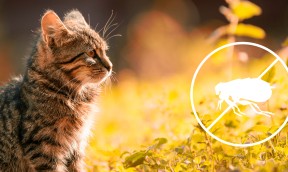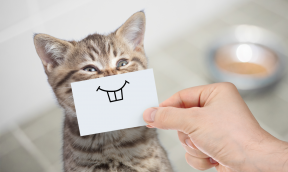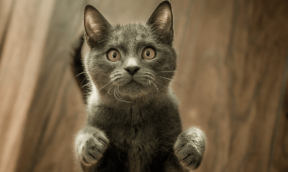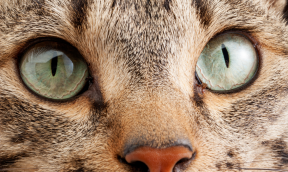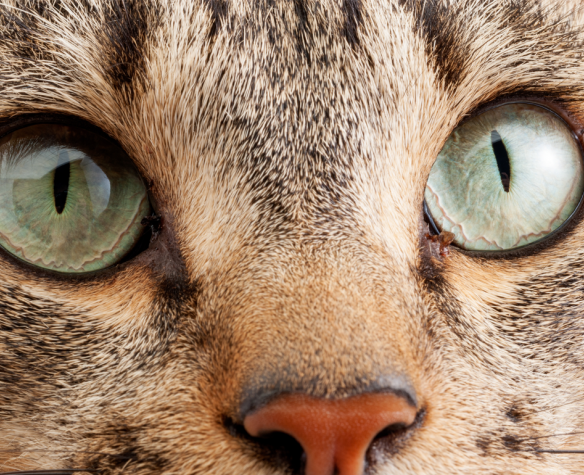
Cleaning a cat’s eyes: best practices and advice
Contents: What are the 4 steps involved in cleaning a cat’s eyes? | What equipment should you use to clean your cat’s eyes? | Why should you look after your pet’s eye hygiene? | How often should you clean a cat’s eyes? | How do you get a kitten or cat accustomed to having its eyes cleaned? | How can you prevent an eye infection in a cat
It’s well known that cats groom themselves extremely well. However, cleaning the area around your cat’s eyes will help maintain eye health and prevent infections. Like brushing its teeth or cleaning its ears, keeping a cat’s or kitten’s eyes clean involves a period of adaptation and great care must be taken to ensure that they let you handle them. Here Francodex gives you expert advice.
What are the 4 steps involved in cleaning a cat’s eyes?
Cleaning your cat’s eyes is an essential routine for keeping them comfortable. Here are the 4 steps to follow after a successful period of adaptation:
- Wash your hands to avoid contamination, or wear gloves if your pet has an eye infection.
- Make yourself comfortable in a quiet place where your cat feels safe. You can wrap it in a towel to restrict its movements and reassure it, depending on what works best with your pet.
- Gently squeeze the bottle and run the eye lotion on the eyelid and around the eye contour area. To avoid getting it in your cat’s eye, or if your cat is frightened when it sees the bottle coming, you can also soak a compress with the lotion and use it to wipe the area around the eye. Wipe off any excess liquid with a compress, taking care not to rub.
- Note that the eye contour area should always be cleaned from the inside (inner corner near the nose) outwards, to avoid carrying impurities back into the tear duct. Use a clean compress for each eye.
- Stroking your pet to reward it and offering it a treat will help associate this care time with a positive event and reinforce appropriate behaviour.
Cleaning a kitten’s eyes follows the same protocol. In general, kittens are more easily handled if you hold them gently on your lap or in the crook of your arm. As far as possible, get your pet used to this type of handling from an early age, to make it easier to treat any infections that may occur.
😽 Tip for cleaning a more sensitive cat’s eyes: for sensitive animals, or those who are frightened of the bottle, we recommend directly wetting a compress with the lotion, then wiping away impurities, without rubbing the skin.
What equipment should you use to clean your cat’s eyes?
Here is a list of equipment needed to clean a kitten’s or cat’s eyes:
- Sterile compresses or make-up removal squares. Avoid tissues, cotton wool or fabrics that can leave fibres behind. Ideally, use non-woven, fibre-free compresses.
- Francodex “Eye Care” cleansing lotion for cats, which maintains good eye hygiene for your adult cat. Made from organic cornflower hydrolate, a cleansing agent and hydrating agent, it can be used at every grooming session.
- Single-use gloves to ensure that your cat’s eyes are not contaminated.
- A soft towel to wrap your pet in (optional, depending on what you usually do).
- A few treats to reward good behaviour.
Make sure you are in a room with optimum lighting. This advice also applies when cleaning your cat’s ears or brushing its teeth.
To keep a kitten’s eyes clean, choose Francodex “Eye Care” cleansing lotion for kittens. It is specially formulated to care for the eye health of younger animals.
With the environment in mind, Francodex also offers a Biodène eye cleanser. Made with 99% natural ingredients, this product contains organic rose and cornflower hydrolate with decongestant and soothing properties. Made in France, the bottle of this eye care product is made from 50% recycled and recyclable plastic.
😺 Cleaning a cat’s eyes with saline solution: if you run out of cleansing lotion, it is best to use saline solution. Buy it in vials or bottles. On the other hand, never use water, even if you have boiled it beforehand, as it is not isotonic with respect to a cat’s tears. As its pH is unsuitable and it contains no antiseptic ingredients, it can irritate the eyes.
Why should you look after your pet’s eye hygiene?
Like humans, cats continuously produce tears to keep their eyes moist and free from debris. This provides a protective film for the cornea.
Day and night, these debris-laden tears can accumulate and form crusts around the eyes, leading to irritation and infections.
The risks increase for cats who go outdoors, as they come into contact with more dust, pollen and other pollutants that can irritate them.
What’s more, some breeds (Persians, Exotic Shorthairs, etc.) are more prone to excessive tearing because of the shape of their face. Brown marks may appear, or even skin problems, around the eyes.
If your cat’s eyes are not cleaned regularly, they can suffer from eye infections caused by pathogens that develop rapidly in the warm, moist environment formed by accumulated tears and debris.
How often should I clean a cat’s eyes?
In breeds prone to excessive tearing and brown marks, it is advisable to clean the eye area twice a week.
In other animals, this hygiene care should be carried out when you notice excessive discharge.
Consult a veterinarian without delay in the following cases:
- the discharge persists,
- your pet's eye turns red,
- secretions are visible on the cornea,
- or simply if it seems to be causing discomfort.
😿 One of my cat’s eyes is closed all the time, what should I do? If your cat’s eyelids are completely closed and you can’t see its eye at all, take it to a vet as a matter of urgency, without trying to intervene. The presence of a foreign body, such as a spikelet of grass in summer, or a misplaced scratch from a fellow cat, can cause considerable damage to the eyes. In such cases, a clean-up would do more harm than good.
How do you get a kitten or cat used to having its eyes cleaned?
To get a kitten or cat used to having its eyes cleaned, start with short, calm sessions.
Choose a time when the cat is relaxed and speak to it softly to reassure it.
Wipe close to its eyes with a cat and dog cleaning wipe, without actually touching the eye. If it lets you do this, reward it with a treat after each session to make it a positive experience.
Gradually extend the length of the sessions until you can clean its eyes completely in good conditions.
Be patient and avoid sudden movements. Over time, your cat will accept this exercise as a normal, stress-free routine.
🙀 Your cat is nervous during eye cleaning: what should you do? If, despite being stroked, wrapped in a soft towel and given a few treats, your cat refuses to let you clean its eyes, talk to your vet. They are experts and will give you specific advice tailored to your pet. Whatever the case, don’t give up on this essential eye-cleaning routine!
How can an eye infection be prevented in cats?
Does your cat have puffy eyes? Does your cat keep its eyes closed? If your pet’s eyes are not as bright and clean as usual, it may have an infection.
Symptoms of an eye infection in cats
Symptoms of an eye infection in cats include:
- redness;
- swelling,
- discharges (clear, yellow or green),
- crusts around the eyes.
The cat may also blink frequently, have watery eyes or be sensitive to light.
In some cases, you may notice your pet rubbing its eye with its paw, which means it is bothered or in pain.
😿 Dry eyes in cats, what can you do? If your vet diagnoses dry eyes in your cat, he or she will advise you on a suitable temporary or long-term treatment. Francodex has also developed a protective eye gel to lubricate dry or irritated eyes. Ask your animal health expert for advice before use.
Causes of eye infection in cats
Infections of the eye surface in cats, such as conjunctivitis, can be caused by:
- bacteria,
- viruses,
- fungi,
- parasites,
- foreign bodies.
In addition, allergies and irritation caused by foreign bodies or chemicals can also lead to infections. Cats that go out a lot, particularly in spring and summer, are more exposed to these pathogens and therefore more likely to develop infections. Their eye hygiene needs to be closely monitored as soon as they come home.
😿The most common eye infections in cats: conjunctivitis, keratitis, uveitis, chalazions and styes, endophthalmitis, feline herpes virus (FHV-1) and mycoplasmosis. Your vet will need to determine the source of the infection to ensure it is treated appropriately.
Cleaning a cat’s eyes in the event of infection
In the event of infection, always clean the eyes and eyelids gently to avoid further irritation. Your cat may be more reluctant to be handled. Be patient!
Use a sterile compress soaked in Francodex cleansing lotion to remove secretions and crusts. Use a fresh compress for each eye to avoid cross-contamination.
Following your animal health professional’s diagnosis, you will need to apply a specific eye treatment according to their recommendations, to ensure a rapid and effective recovery (eye drops, antibiotic ointments, etc.).
Article written with the assistance of
Dr Stéphanie Padiolleau, veterinary surgeon

